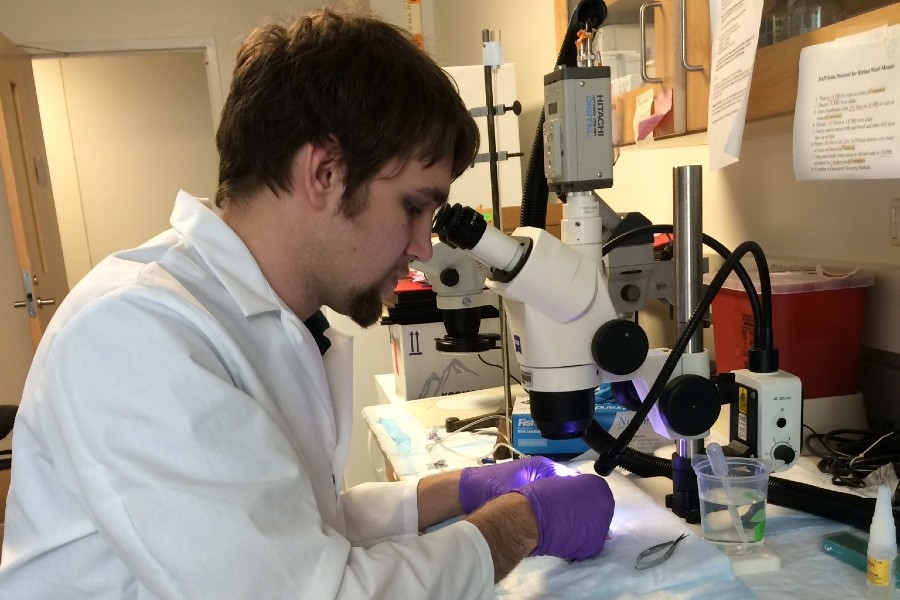Alumnus is helping to keep us all healthier through research at Yale
Dan Midgett explored the causes of glaucoma at Johns Hopkins and is working to help heart failure patients at Yale.
Janel Shoun-Smith | 615.966.7078 |

After leaving the Lipscomb campus, engineering graduate Dan Midgett has gone from studying abalone seashells in Auburn, Georgia, to studying the human eye at Johns Hopkins Medicine and now to working to help the heart recover after a heart attack at a cardiology lab at Yale University.
And it all started with playing with Legos as a child in Lebanon, Tennessee, and a Lipscomb mechanical engineering degree in 2012.

Dan Midgett ('12)
Midgett is a post-doctoral fellow in biomedical engineering in a cardiology laboratory of Yale Medical School. He works to design the technology needed for medical scientists to conduct specific experiments.
As a child, Midgett was always “building sophisticated Lego creations and games for other kids to play with,” so he had an inkling he would make a good engineer. But he also discovered a love for marine biology, and his Lipscomb engineering mission trips to the Ulpan Valley in Guatemala taught him that he wanted his work to benefit people. Biomechanics brought biology and his Christian mission together in one career.
It was on the advice of Lipscomb engineering professor Fort Gwinn that Midgett majored in mechanical engineering instead of going to another university to major in biomechanics. Gwinn said that a basic engineering degree would prepare him better for graduate school and medical research.
Gwinn was right, said Midgett. “I learned the foundational concepts that underpin the way I do things today,” he said, referring to mechanical engineering and science courses at Lipscomb.

Midgett is helping to test a hydrogel on porcine hearts suspended in a preservation tank through computer modeling.
He also tapped Gwinn for a recommendation to get into a summer research program in biomechanics that set him on his path to the Ivy League. As a junior, he was accepted for a National Science Foundation research program at Auburn University where he worked with scanning electron imaging of the structure of abalone seashells.
A good recommendation from Auburn got him into Johns Hopkins Whiting School of Engineering to earn his master’s and Ph.D. in biomechanics. For six years he worked on ocular biomechanics to support research into the development of glaucoma, how vision loss takes place and what features of the eyes might indicate a greater possibility of developing glaucoma later in life.
Specifically, Midgett developed new imaging techniques to quantify how tissue is strained in the eye due to adverse pressure and how that relates to the damage caused by glaucoma.
“In some people’s eyes, the tissue strain is caused by adverse pressure. Higher amounts of tissue strain affect the nerves as they leave your eye (and go to the brain). I developed experiments to change the pressure in the eye and measured the tissue strain in sick and healthy patients,” said Midgett.
“I developed equipment to control the pressure in the eye to allow us to map how the collagen structure changes and strain is distributed and how that correlates to the progression of glaucoma,” he said. “We were working with post-mortem tissues, but at the end (of his time at Johns Hopkins), I was working on some ways to apply this study to samples in the clinic with patients.”
After earning his Ph.D., Midgett moved on to his postdoctoral fellowship at Yale, where he is working for at least the next year. The Yale post will give him more experience in his main interest: developing computer models to show how healing or changes due to disease can be measured over time.

At Lipscomb, “I learned the foundational concepts that underpin the way I do things today,” said Midgett.
At Yale, “We are researching a new therapy to apply after a heart attack,” said Midgett. “After an attack, you have reduced blood flow to the heart, which causes pain and the tissue dies. As it heals, the tissue scars, and the heart can become misshapen. We are testing a hydrogel that will thicken and support the heart wall as it heals. This will reduce the risk of future heart attacks, which can be a common occurrence.”
The Yale team, with their collaborators at the University of Pennsylvania, is testing the hydrogel on porcine hearts suspended in a preservation tank and computer modeling is used to simulate the heartbeat under certain conditions.
Midgett said the next step for the researchers is to test the hydrogel therapy on hearts that have been kept alive after removal, a field of study fueled by organ donation procedures.
Midgett says he enjoys the global perspective he gets at Yale, working with experts from all over the world to tackle health problems.
After his post-doctoral fellowship ends, Midgett plans to continue using his talents to further expand the envelope of bioengineering possibilities. If his journey thus far is any indication, his research will continue to bless lives.